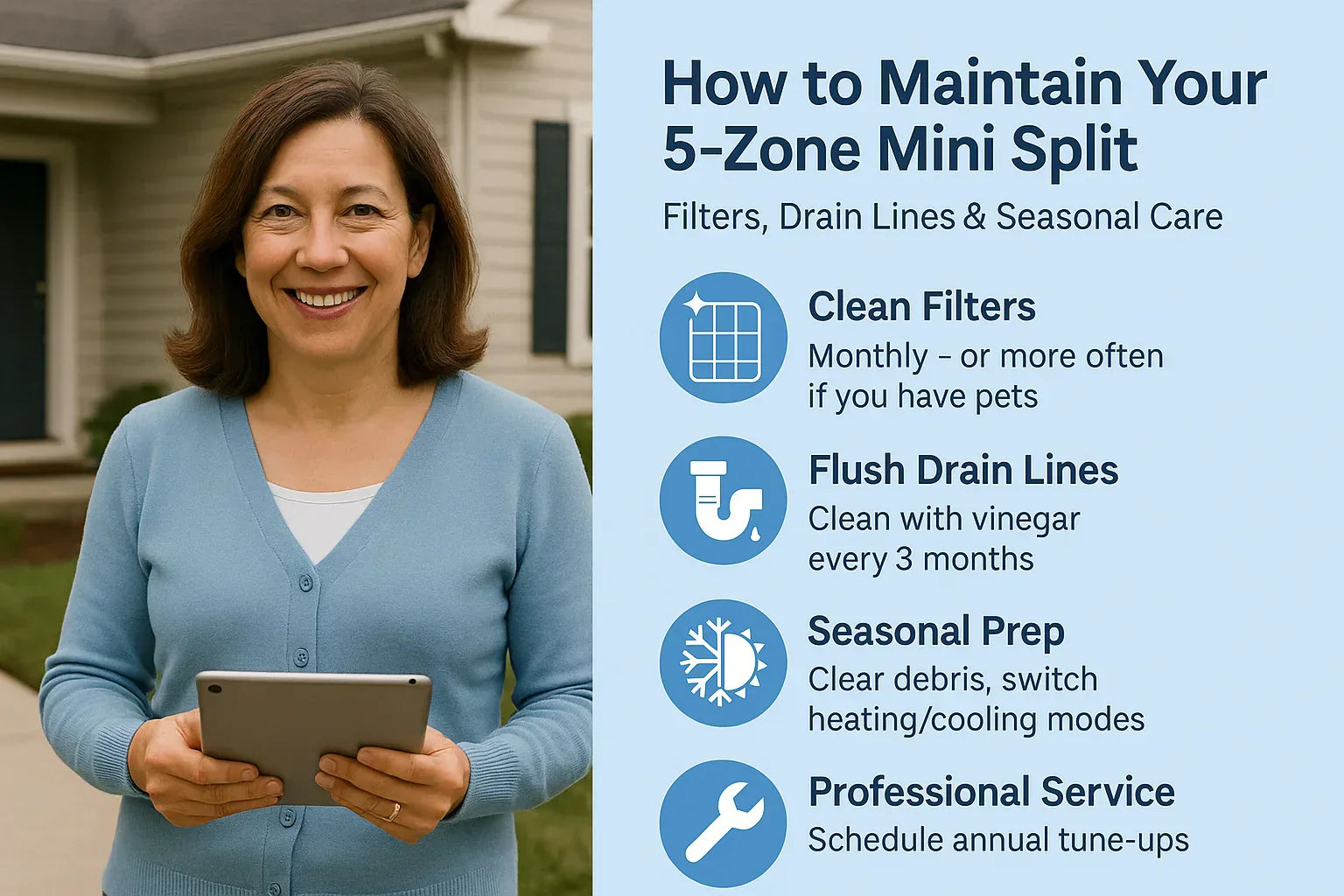🧼 1. Why Maintenance of 5-Zone Mini Split Matters: Protect Your Investment
-
A well-maintained mini split can last 15–20 years, while neglected systems often fail in 7–8 years
-
Routine maintenance improves airflow, lowers energy bills (up to 25% energy savings), and reduces repair risk
-
Cleaning coils, filters, and drains also helps prevent mold and odors inside indoor units
For Samantha, keeping her system efficient saves money and ensures comfort across all five zones.
🌀 2. Filter Maintenance by Zone: How Often & How-to Clean
🔹 Recommended Schedule:
-
Ideally, clean or wash filters every month; every 1–3 months if no pets/allergies and home is clean
🔹 Cleaning Steps:
-
Turn off the unit and, if older, switch off power at breaker
-
Open indoor panel and gently remove filters.
-
Vacuum lightly, then wash with mild detergent and rinse airflow direction → dry completely (takes ~4 hours)
-
Reinstall carefully, ensuring seated correctly.
🔹 Why It Matters:
-
Dirty filters reduce airflow, strain the compressor, raise energy use, and can degrade indoor air quality (especially for kids and allergy sufferers)
Do Mini-Splits Have Filters, and How Do I Care for Them?
💧 3. Drain Line Do’s & Don’ts: Prevent Leaks & Mold
⚠️ Why It’s Crucial:
-
Clogged or clogged drain lines lead to water backup, indoor leaks, and even mold growth on walls or floors
✅ What Samantha Does Every 3 Months:
-
Locate the condensate drain line exiting the indoor unit.
-
Flush with distilled vinegar or clean water to dissolve slime and clear debris.
-
Use a wet/dry vacuum at the drain termination to verify flow (the same approach the Furnace Outlet recommends)
📌 Pro Tips:
-
Keep access holes sealed and gently sloped if installing new lines.
-
Install a condensate pump if gravity drainage is not possible (e.g. mid-wall or drain-pan installations)
How to Run Drain Pipe for a Mini-Split System
🌀 4. Seasonal Care: How Samantha Preps by Season
| Season | DIY Tasks (Samantha does) | Pro Tune-Up Recommended? |
|---|---|---|
| Spring | Clean outdoor unit debris, remove snow covers, test filters | ✅ Yes, before summer use |
| Summer | Clean indoor filters, monitor drain, inspect airflow | Optional if DIY is consistent |
| Fall | Clean outdoor coils, reverse airflow direction for heating | ✅ Yes, before winter season |
| Winter | Monitor heat output, check for frost buildup | ✅ If poor heating or inefficiency noticed |
-
Clearing debris around the outdoor unit and checking that the outdoor base stays level is crucial for airflow and performance
-
Flipping controls between cooling and heating before seasons ensures proper operation.
-
Scheduling a professional tune-up twice per year (started before peak seasons) helps maintain efficiency and identify issues early
🧼 5. Cleaning Coils, Outdoor Units & Fan Blower
Samantha includes these in her quarterly maintenance:
-
Inspect indoor evaporator coils for dust; if heavy buildup, call pro for bleach cleaning or coil servicing
-
Keep outdoor condenser coils clear of leaves, grass, and dirt—use a gentle hose spray (not power washer) after shutting off power
-
Check fan/blower wheel noise and airflow—excess dirt or imbalance reduces efficiency; report for balancing or cleaning if needed
🙋♀️ 6. When to Call a Pro: Knowing Red Flags & Annual Help
📍 Red Flags Samantha Watches For:
-
Reduced airflow or weak performance in one zone
-
Accumulating water or leaks around indoor units
-
Ice forming on indoor coils or refrigerant lines
-
Strange sounds (humming, rattling), or unusual odors
-
Unexpected increase in energy bills without changed usage
📅 Pro Tune-Up Frequency:
-
Twice per year (spring and fall) for systems backing both cooling and heating seasons; yearly minimum if single-split use
-
Typical cost: $260–$550 per visit, but investment prevents more expensive repairs—HVAC provider plans cost around $290/year average
What a pro does:
-
Check refrigerant pressure, tighten electrical connections
-
Deep-clean hidden components and coils
-
Verify thermostat calibration and test system response
-
Diagnose potential refrigerant leaks or wiring issues
📅 7. Samantha’s Maintenance Calendar: A Sample Year
| Month | Task | Who Does It |
|---|---|---|
| January | Outdoor unit check and debris clearance | Samantha |
| February | Flush drain lines; filter check | Samantha |
| March | Pro tune-up (before cooling season) | HVAC Tech |
| April – July | Monthly filter clean; check airflow | Samantha |
| August | Clean outdoor coils; remove covers | Samantha |
| September | Flush drains; reverse mode test | Samantha |
| October | Pro tune-up (before heating season) | HVAC Tech |
| November | Inspect indoor units and filter maintenance | Samantha |
| December | Monitor heat run and snow clearance | Samantha |
This schedule ensures smooth performance across busy cooling and heating months.
✅ Summary & Checklist: Samantha’s Maintenance Routine
🟢 Monthly (DIY):
-
Clean/wash filters
-
Dust indoor unit and wipe louvers
🔵 Quarterly (DIY):
-
Flush drain lines
-
Clear debris around outdoor unit
-
Inspect coils and airflows
⚙ Professional (6–12 Months):
-
Full system inspection
-
Refrigerant check and electrical test
-
Coil servicing and thermostat calibration
-
Warranty & performance validation
📚 External Verified Sources
-
The Furnace Outlet seasonal maintenance summary — ideal for Samantha’s routine
-
HVAC.com recommendations for filter and professional maintenance
-
Aireserv systematic maintenance checklist for DIY and pro tasks
-
Time.com seasonal AC maintenance reminders and filter advice
In the next topic we will know more about: Common 5-Zone Issues and Fixes: What to Do If One Zone Stops Cooling or Heating







